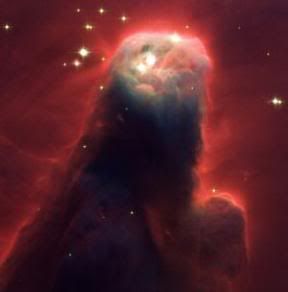|
|
Post by glactus on Jan 15, 2009 7:36:38 GMT
 The Cone nebula The Cone Nebula (also known as NGC 2264) is an H II region in the constellation of Monoceros. It was discovered by William Herschel in 1785. The nebula is located about 2,600 light-years away from Earth and is part of the nebulosity surrounding the Christmas Tree Cluster. Magnitude is variable The diffuse Cone Nebula, so named because of its apparent shape, lies in the southern part of NGC 2264, the northern part being the magnitude-3.9 Christmas Tree Cluster. It is in the northern part of Monoceros, just north of the midpoint of a line from the stars Procyon to Betelgeuse. The cone's shape comes from a dark absorption nebula consisting of cold molecular hydrogen and dust in front of a faint emission nebula containing hydrogen ionized by S Monocerotis, the brightest star of NGC 2264. The faint nebula is approximately seven light-years long. It is part of a much larger star-forming complex—the Hubble Space Telescope was used to image forming stars in 1997.  Credits: This is a NASA/Hubble image |
|
|
|
Post by Andy Mac on Jan 16, 2009 12:42:13 GMT
This area is a beautiful mixture of both emission & reflection nebulosity - all of which surrounds a lovely cluster, commonly dubbed the 'Christmas Tree cluster'. The nebula is very difficult to observe (I have never seen it) but the cluster is a lovely sight. My best view was a few years back now, through my 11" SCT and appropriately viewed on a clear night between Christmas & New Year. The Christmas tree shape was obvious with S Monocerotis stealing the show! Unforgettable!  |
|